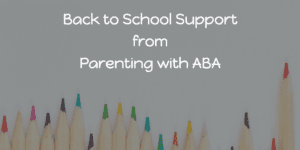
“I’d really like to work with my son on pre-K and kindergarten skills before school starts back up, but whenever I get out the flashcards or workbooks, I cannot get him to sit still at the table with me. Please help!”
While I applaud your aspirations to teach academic skills at home I’m not going to directly answer your request. I’m so helpful. I know.
How about instead of working on ways to get your son to sit and do traditional academic tasks, let’s focus on more creative ways to teach your son these same pre-academic skills.
In ABA, we often use a technique called Natural Environment Training (or NET). This means that we teach using the things in the child’s natural environment- throughout the day- using toys and play as teaching tools. In a rich environment, your child will choose what they want to play with. Follow their lead and use these toys and activities to teach a skill.
By letting your son choose what he wants to play with, you can use his own motivation to drive learning instead of trying to convince him to sit still at the table and do an activity (ahem, workbooks) that is not at all motivating to him.
You may be thinking, “She wants me to just play with my son. How does that teach him these academic skills I’m wanting to work on?”
You can use all kinds of toys and games to teach academic skills, classroom appropriate behaviors, and social skills to get ready for back-to-school time.
Let’s look at some ideas and examples:
- Books! I love reading to my own child and find all kinds of things to teach in her books. If you are reading a book about cars- use adjectives of every kind along the way. Touch the red car. Where’s the big car? You can teach colors and adjectives so easily with books. What about numbers? How many cars are on this page? You can always do some basic reading comprehension questions. What happened to the boy in the story? What happened first? How did the bunny feel? Books are such an easy tool to use to teach specific skills but to keep your child’s attention and use their own motivation.
- Ball toys. You can count how many balls are in the toy bin. Count how many times you bounce the ball. Pass the ball back and forth saying the ABCs in order with each turn. Or anything else that has an order to it- planets, state names, whatever! Name the colors of all the balls in the toy bin.
- Puzzles. Count the pieces. Where’s the blue one? What’s on this puzzle piece? Am I starting to sound like a broken record with these questions/ prompts?
- Board games. Teach turn-taking, colors, letters, shapes- you name it! Find everything on the board itself and the game pieces you can identify. Practice both winning and losing gracefully. Talk about the game while you are playing it to practice conversation skills; compliment each other; find appropriate ways to communicate competitiveness.
The list of examples can go on and on and on. The big picture idea here is to find creative ways in your child’s natural environment to teach the skills you are wanting to work on. Your son isn’t motivated to sit at the table and do flash cards. In the summer. No big surprise there, huh? Use the things that he IS motivated by and practice all those academic and pre-academic and social skills.
Your child wants to play. You want them to practice specific skills before school starts. Marry those two things. Teach through play. Once you get into it, it’ll be more fun for both of you!
Spend some time watching your child play and think about his favorite toys. Be intentional about what you can teach with these toys or activities he’s already in to. Take a little time to make a mental plan and then get in there and play with your child!
Make sure you don’t turn all fun activities into a question and answer period where your son feels like he’s just being drilled. Intersperse those questions, prompts, and teaching opportunities during his natural play. Don’t take over the play and turn it into and un-fun flash card time. Continue to follow his lead, play with him, and throw in those learning opportunities as you go!


Recent Comments